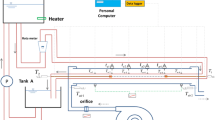Abstract
Heat transfer characteristics of the countercurrent gas-solid flow inside verical pipes has been investigated with the shell and tube type heat exchanger. Sand particles having the average particle diameter of 1.0 and 1.7mm were used. The effect of gas velocity and sand paticle flow rate on the heat transfer rate and the pressure drop were examined. At room temperatures, the predicted pressure drop agrees well with the experimental results when the larger sand particles are used. The results shows that there exists an optimum sand particle flow rate at which the heat transfer rate become maximum. The increase in the heat transfer coefficient due to sand particles was obtained up to 62%.
Similar content being viewed by others
Abbreviations
- C DM :
-
Drag coefficient of gas-particle maixture
- C DS :
-
Drag coefficient of single particle
- D :
-
Inner diameter of pipe
- F :
-
Force
- f :
-
Friction coefficient
- g :
-
Gravitational constant
- L :
-
Length of pipe
- m :
-
Mass flowrate
- Δm p :
-
Effective mass of sand particles
- Nu :
-
Nusselt number (hD/k)
- Pr :
-
Prandtl number
- Re :
-
Reynold number (ρUd p /μ)
- t :
-
Time
- U :
-
Velocity
- z :
-
Axis along the pipe
- ε:
-
Porosity
- μ:
-
Viscosity
- ρ:
-
Density
- τ:
-
Shear force
- a :
-
Accelerational
- b :
-
Bulk temperature
- f :
-
Fluid, frictional
- g :
-
Gas, gravitational
- p :
-
Particle
- s :
-
Surface, solid particle
- w :
-
Wall
References
Arastoopour, H. and Gidaspow, D., 1979, “Vertical Countercurrent Solids Gas Flow,” Chem. Eng. Sci, Vol. 34, pp. 1063–1066.
Boumehdi, L. Guigon, P. and Large, J.F., 1985, “Heat Recovery from Solids in a Raining Bed Exchanger,” Heat Recovery Systems, Vol. 5, No. 5, pp. 407–414.
Colbum, A.P., 1933, “A Method of Correlating Forced Convection Heat Transfer Data and Comparison with Fluid Friction,” Trans. AIChE Vol. 29, pp. 174–210.
Depew, C.A. and Kramer, T.J., 1973, “Heat Transfer to Flowing Gas-Solid Mixture,” Advances in Heat Transfer, Vol. 9, Academic Press, pp. 113–180.
Farbar, L. and Morley, M.J., 1957, Ind. Eng. Chem., Vol. 49, p. 1143.
Konno, H. and Saito, S., 1969, J. Chem. Eng. Japan, Vol. 2, p 211.
Nusselt, W., 1931, “Der Warmeaustausch Zwischen Wand und Wasser in Rohr,” Forsch, Geb. Ingenieurwes, Vol. 2, p309.
Sider, E.N. and Tate, C.E., 1936, “Heat Transfer and Pressure Drop of Liquids in Tubes,” Ind. Eng. Chem. Vol. 28, p. 1429.
Weierman, R.C., 1982, “Design of Heat Transfer Equipment for gas-side Fouling Service, in Workshop on an Assessment of Gas-side Fouling in Fossil Exchaust Environments Ed. by W.J. Marner and R.L. Webb, Publication 82–67. Jet Propulsion Lab., July.
Yang, W.C., 1976, “International Powder and Bulk Solids Handling and Processing Conference Exposition,” Chicago, May 11–14.
Author information
Authors and Affiliations
Rights and permissions
About this article
Cite this article
Park, Si. Heat transfer in countercurrent gas-solid flow inside the vertical pipes. KSME Journal 5, 125–129 (1991). https://doi.org/10.1007/BF02953611
Received:
Issue Date:
DOI: https://doi.org/10.1007/BF02953611




